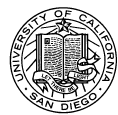




 |
 |
|
 |
 |


Berkeley • Davis • Irvine• Los Angeles • Merced • Riverside • San Diego • San Francisco • Santa Barbara • Santa Cruz
SENIOR VICE PRESIDENT —
BUSINESS AND FINANCE |
January 3, 2000 |
VICE CHANCELLOR BARCLAY
VICE CHANCELLOR BLACKMAN
ASSOCIATE VICE PRESIDENT BOYETTE
VICE CHANCELLOR BRASE
VICE PRESIDENT BROOME
ACTING ASSOCIATE VICE PRESIDENT DOLGONAS
VICE CHANCELLOR RELYEA
VICE CHANCELLOR VANI
Subject: A New Business Architecture for the University of California
There has been much discussion about the impact of enrollment growth on the University of California from now until the year 2010. This discussion has focused primarily on the impact on student growth, the capital program, faculty recruitment, academic programs, and other related issues. However, there also needs to be serious consideration given to the impact of this growth on the business functions of the University.
Between the years 2000 and 2010, significant enrollment growth will be accompanied by growth in innovative industrial partnerships, philanthropy, sponsored research, complexity of government regulations, and increased scrutiny by our constituents. These factors will markedly increase business transactions on the campuses and the Office of the President. It is also likely that during the coming decade, we will not see a proportionate investment in the administrative infrastructure to adequately handle this increase in transactions and workload.
At the recent Administrative Vice Chancellor retreat, we discussed the need to begin thinking about a New Business Architecture that would allow campus departments, administrative operations, and UCOP to support the growth of the University over the next decade. I ask that you participate in a small planning group to consider elements of this architecture, which may include the following seven components:
- Process Redesign Component: A focused approach to redesign a core set of business processes, common to all campuses, in order to reduce the transactional workload of campus academic departments and functional offices;
- HR Component: A Human resources strategy that increases UC's competitiveness in a tight labor market and includes aggressive recruitment approaches, flexibility in compensation, and work life policies that will attract and retain the next generation of staff;
- Web Business System Component: A Web-based infrastructure for business processes that provides intuitive navigation and seamless integration among business applications, policies, expert help, and online training;
- Internal Controls Component: An internal controls framework that ensures continuation of an appropriate stewardship of UC's resources, is driven by risks identified by the campuses, and is responsive to the Office of the President and Regents' oversight of University assets;
- Financial Reporting Component: A new model for consolidating and communicating campus financial, payroll, and personnel information to UCOP utilizing emerging internet-based standards, resulting in improved resource management and more timely and flexible reporting;
- E-Commerce Component: A coordinated effort to leverage e-commerce strategies to streamline campus transactions with vendors, staff, and the Office of the President;
- Organizational Performance Component: A management tool that will allow campuses to collect key metrics that assess the effectiveness of the overall business architecture including financial performance, process effectiveness, and our ability to meet the needs of our customers and constituents.
I anticipate that the report of this planning group will serve as a context and starting point for a series of strategic initiatives that will reshape how the University conducts its business in order to support UC's growth over the next decade. I have asked Vice Chancellor Steve Relyea to chair the planning group and Director Kris Hafner has agreed to staff the group. I ask that you provide your report to me by June 1, 2000.
I am prepared to meet with the committee on a frequent basis to further develop the above components. Your participation in this important effort is appreciated.
Sincerely,
V. Wayne Kennedy
Senior Vice President
cc: President Atkinson
President's Cabinet
Chancellors
Vice Chancellors for Administration
|
 |
| |
|
 |
|



